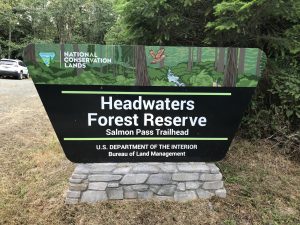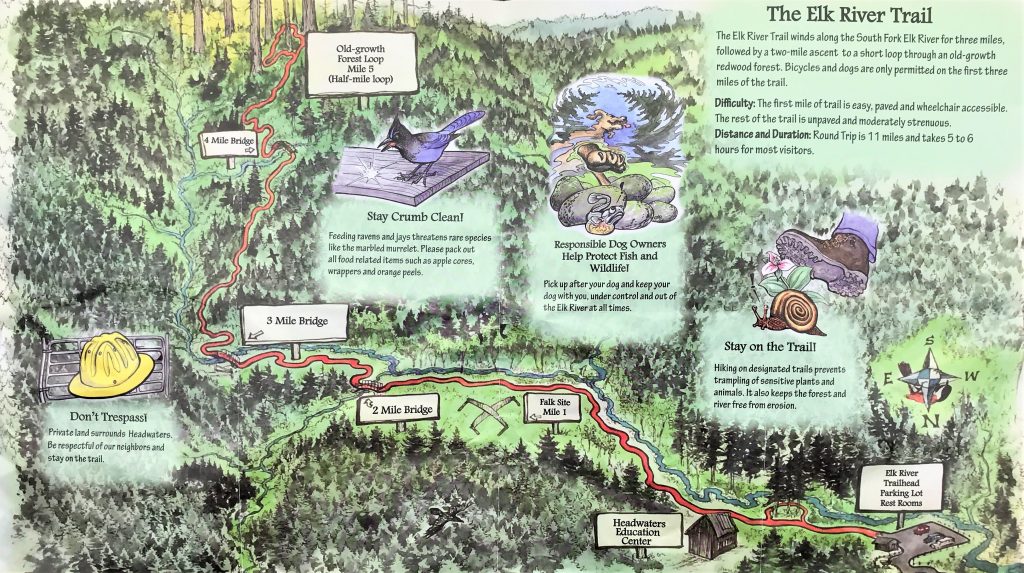Hiking the Headwaters Forest Reserve
 The Headwaters Forest Reserve, near Eureka, California, was formed in 1999. I’ve been eager to visit it ever since. Last week, my daughter and I finally realized my goal. Check out my photo album.
The Headwaters Forest Reserve, near Eureka, California, was formed in 1999. I’ve been eager to visit it ever since. Last week, my daughter and I finally realized my goal. Check out my photo album.
About Redwood Forests
I love redwood forests. I find them calming and spiritual. Photos and videos never do justice to redwood forests. You have to experience them firsthand. Whenever tourists ask me about what to do in California, visiting a redwood forest is my top recommendation. A person’s first visit to a redwood forest often changes their worldview forever.
Not everyone shares my passion for redwood forests. A common sentiment: if you’ve seen one redwood grove, you’ve seen them all. If you agree, then the Headwaters Forest Reserve probably isn’t for you. You can find nice old-growth redwood groves that are easier to get to.
About the Headwaters Forest Reserve
Redwood forests thrive in central and northern California’s coastal area. Loggers have logged old-growth redwood trees for 150+ years. The logging leads to second-growth groves, which are degraded both biologically and scenery-wise.
By the 1980s, few large areas of old-growth redwood groves hadn’t been logged and remained unprotected by the government. Headwaters Forest was the largest remaining old-growth redwood forest in private hands. Pacific Lumber owned it. Although all logging of old-growth redwoods hurts the ecosystem, Pacific Lumber was regarded as a relatively gentle land steward. That made them a juicy target for a corporate raider. Charles Hurwitz of Maxxam did a hostile takeover of Pacific Lumber and initiated more old-growth clear-cutting. Activists pushed back and turned Headwaters Forest into a cause celebre. This spurred Congress and California to purchase 7,472 acres of the Headwaters Forest for $380M.
There are two public access points. On the north side is the Elk River Trail, which the public can access without restriction. On the south side is the Salmon Pass Trail, which can be accessed only via a ranger-led tour. The reserve’s heart, about 2,500 acres of unbroken old-growth redwoods, has no public access.
The Elk River Trail
Access to the Elk River Trailhead is via the paved Elk River Road, about 15 minutes from Eureka. Along the way, check out the covered bridges at Zane’s Ranch and Bertas Ranch. The road ends at a paved parking lot.
The trail is 11 miles roundtrip. This map (apparently not available elsewhere online) depicts the trail:
The trail has landmarks every mile:
- Mile 1: the paved trail ends at the site of Falk, an abandoned company town. There are few artifacts remaining. Check out this video on Falk. There are some picnic tables around here if you want to lunch with the mosquitos. The first mile had educational signage and two bypass trails on the southside. A short bypass is marked on the map; the longer bypass isn’t.
- Mile 2 bridge. More buggy picnic tables near here.
- Mile 3 bridge. The trail’s steepest and most overgrown parts start here.
- Mile 4 bridge (actually a small boarded crossing over a creek, and the map doesn’t depict a second boarded crossing soon after). We think the mile 4 bridge is more like 4.25 miles from the start.
- Mile 5: the beginning of the old-growth loop.
The mile-apart spacing of the landmarks made it easy to track our progress. At our hiking speed, each landmark was roughly 30 minutes apart. The trail is nicely graded, well-maintained, and well-signed, making navigation a breeze. Everything about the trail is in great condition.
The scenery is standard for the area. The first three miles follow the riverbed. We enjoyed snacking on trailside vine-ripened blackberries and other edible berries. We saw plenty of flowers in early August. Until the old-growth loop, the forests are clearly second-growth–nice but unremarkable. The trail’s big payoff is the old-growth loop. Still, per my introductory remarks, it looks like other old-growth redwood groves.
The bottom line: this is a lovely 5 hour hike through typical North California terrain. But if your goal is to see old-growth redwoods, you can find just-as-nice groves that are quicker to reach.
The Salmon Pass Trail
The Salmon Pass Trail requires advance reservations. The gathering point is at Newburg Park in Fortuna. A sign near the parking lot entrance lets you know you’re at the right place. Ranger Julie led our tour. She offered to give us a ride, but we followed her in our own car. The road to the trailhead passes over private property, so it is restricted by a gate. The road is mostly dirt/gravel and has a few steep parts that strained the Prius, but the Prius had enough ground clearance to handle the road.
Like the Elk River Trail, the Salmon Pass Trail hikes through logged areas to reach an old-growth redwood grove. The contrast between the logged and old-growth areas was stark. Some of the areas were clearcut within the last 40 years. Those areas are dominated by red alder trees that, over the centuries, will give way to the redwoods. As with the Elk River Trail, the old-growth grove is great but looks like other old-growth groves. Many redwoods were marked with blue paint, indicating that they had been scheduled for cutting. I’m so glad they survived. The trail runs about 4 miles, and our group spent about 3 hours on the trail (plus the drive time to/from Newburg Park to the trailhead).
If you have to pick between the Elk River and Salmon Pass trails, I’d recommend the Salmon Pass hike. Both trails are beautiful, but Salmon Pass is shorter and benefits from expert narration. However, if your schedule doesn’t sync with the Salmon Pass reservation options, you’ll still enjoy the Elk River trail a lot. If your goal is to experience an old-growth redwood grove with as little time investment as possible, then skip both hikes and go to the Avenue of the Giants, which has multiple awesome old-growth grove options right along the road.
Other Nearby Attractions
On this trip, we also stopped at the following places:
- Avenue of the Giants. One of the most beautiful auto tours anywhere. The road runs along the river and weaves through wonderful redwood forests, dotted by quaint towns and quirky roadside attractions/tourist traps. Our favorite stops were the Founder’s Grove and the Gould Grove trail across from the visitor’s center, but all of the stops are great (though, if you think redwood groves are all the same, they may feel redundant). Although the groves are part of the Humboldt Redwoods State Park, access is free. The Humboldt Redwoods State Park has many other first-rate trails; it’s the world’s largest remaining old-growth redwood forest.
- Humboldt Bay National Wildlife Refuge. Conveniently located off the 101, it’s easily overlooked. We hiked the Shorebird Loop Trail and, in less than an hour, saw bunnies, a skunk, a deer, and many birds, especially egrets on the hunt. We saw plenty of flowers in early August. This place would be awesome at sunrise and sunset, but it’s only open 9-5.
- Ferndale. A little touristy for my tastes, but the Victorian-era buildings are amazing.
- Downtown Fortuna. My 15 year old daughter loved seeing an old-school downtown like this. Perhaps it’s not as scenic as Ferndale, but it feels more authentic.
- Old Town Eureka. More Victorian gems, including the amazing Carson Mansion and the Pink Lady across the street. We enjoyed watching the harbor seals.
Though we didn’t visit them on this trip, I also love the Redwoods National Park and Prairie Creek State Park further north of Eureka. Gold Bluffs Beach (including the elk herd!) and Fern Canyon are stunning.

